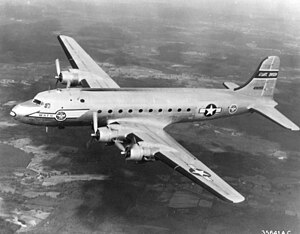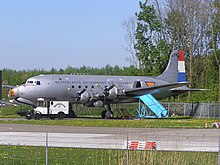
The Douglas C-124 Globemaster II, nicknamed "Old Shaky", is an American heavy-lift cargo aircraft built by the Douglas Aircraft Company in Long Beach, California.

The Douglas DC-4 is an American four-engined (piston), propeller-driven airliner developed by the Douglas Aircraft Company. Military versions of the plane, the C-54 and R5D, served during World War II, in the Berlin Airlift and into the 1960s. From 1945, many civil airlines operated the DC-4 worldwide.
This is a list of aviation-related events from 1950:

The Sikorsky CH-54 Tarhe is an American twin-engine heavy-lift helicopter designed by Sikorsky Aircraft for the United States Army. It is named after Tarhe, an 18th-century chief of the Wyandot Indian tribe whose nickname was "The Crane". The civilian version is the Sikorsky S-64 Skycrane.

The Lavochkin La-11 was an early post-World War II Soviet long-range piston-engined fighter aircraft. The design was essentially that of a Lavochkin La-9 with additional fuel tanks and the deletion of one of the four 23 mm Nudelman-Suranov NS-23 cannons. Like the La-9, the La-11 was designed to be a low to medium-altitude general-purpose fighter, although the additional fuel tanks were added with the intent of employing the La-11 in the escort fighter role.

The Douglas C-74 Globemaster was a United States heavy-lift cargo aircraft built by the Douglas Aircraft Company in Long Beach, California. The aircraft was developed after the Japanese attack on Pearl Harbor. The long distances across the Atlantic and, especially, Pacific oceans to combat areas indicated a need for a transoceanic heavy-lift military transport aircraft. Douglas Aircraft Company responded in 1942 with a giant four-engined design. Development and production modifications issues with the aircraft caused the first flight to be delayed until 5 September 1945, after both V-J Day and formal surrender on September 2. Total production was limited to 14 aircraft when the wartime contract was cancelled in January 1946.

Buffalo Airways is a family-run airline based in Yellowknife, Northwest Territories, Canada, established in 1970. Buffalo Airways was launched by Bob Gauchie and later sold to one of his pilots, Joe McBryan. It operates charter passenger, charter cargo, firefighting, and fuel services, and formerly operated scheduled passenger service. Its main base is at Yellowknife Airport. It has two other bases at Hay River/Merlyn Carter Airport and Red Deer Regional Airport. The Red Deer base is the main storage and maintenance facility. The airline is also the subject of the History television reality series Ice Pilots NWT.
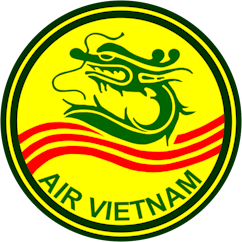
Active from 1951 to 1975, Air Viet Nam was South Vietnam's first commercial air carrier, headquartered in District 1, Saigon. Established under a decree by Chief of State Bảo Đại, the airline flew over two million passengers, throughout the Vietnam War, and until its collapse due to the Fall of Saigon.

N'Djamena International Airport serves N'Djamena, the capital city of Chad. It is the country's only international airport. The airport is dual use, with civilian and military installations on opposite sides of the single runway.

The Tachikawa Ki-54 was a Japanese twin-engine advanced trainer used during World War II. The aircraft was named Hickory by the Allies.

The Canadair North Star is a 1940s Canadian development, for Trans-Canada Air Lines (TCA), of the Douglas DC-4. Instead of radial piston engines used by the Douglas design, Canadair used Rolls-Royce Merlin V12 engines to achieve a higher cruising speed of 325 mph (523 km/h) compared with the 246 mph (396 km/h) of the standard DC-4. Requested by TCA in 1944, the prototype flew on 15 July 1946. The type was used by various airlines and by the Royal Canadian Air Force (RCAF). It proved to be reliable but noisy when in service through the 1950s and into the 1960s. Some examples continued to fly into the 1970s, converted to cargo aircraft.
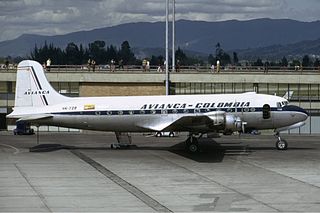
Avianca Flight 03 was a passenger flight from Cartagena, Colombia to Bogotá, Colombia that crashed on January 14, 1966. After takeoff, as the aircraft reached 100 ft (30 m), it stalled and crashed into shallow water. After a 14-month investigation, engine failure was found to be a possible, but unproven, cause. Poor maintenance and inadequate inspections were also suspected.
Transocean Air Lines was an airline based in the United States that operated from 1946, when it was established as ONAT (Orvis Nelson Air Transport Company), until its bankruptcy in 1960. It was based in Oakland, California.
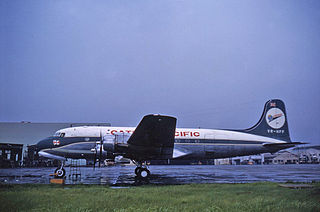
The 1954 Cathay Pacific Douglas DC-4 shootdown was an incident on 23 July 1954, when a Cathay Pacific Airways C-54 Skymaster airliner was shot down by People's Liberation Army Air Force fighter aircraft. The event occurred off the coast of Hainan Island, where the plane was en route from Bangkok to Hong Kong, killing 10 of 19 passengers and crew on board.

The crash of Canadian Pacific Air Lines Flight 3505 occurred on 21 July 1951 when a Douglas DC-4 four-engined piston airliner registered CF-CPC of Canadian Pacific Air Lines disappeared on a scheduled flight for the United Nations from Vancouver, Canada, to Tokyo, Japan. Neither the aircraft nor the 31 passengers and six crew have been found. The incident marked the first aircraft loss during the Korean Airlift.

On 26 January 1950, the Douglas C-54 Skymaster serial number 42-72469 disappeared en route from Alaska to Montana, with 44 people aboard. The aircraft made its last radio contact two hours into its eight-hour flight. Despite one of the largest rescue efforts carried out by a joint effort between Canadian and US military forces, no trace of the aircraft has ever been found.
